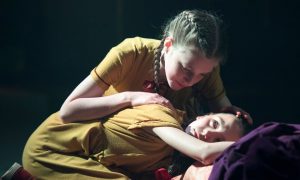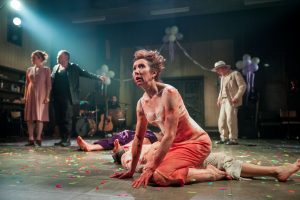 Around this time last year I was asked by the award-winning playwright, director and screenwriter Zinnie Harris to write a programme note for the Edinburgh International Festival revival of the acclaimed ORESTEIA: THIS RESTLESS HOUSE. The trilogy was written by Zinnie and directed by Dominic Hill, artistic director of the Citizens Theatre. (The trilogy was originally a Citizens Theatre production in 2016, and the revival was again the Citizens production in association with the National Theatre of Scotland).
Around this time last year I was asked by the award-winning playwright, director and screenwriter Zinnie Harris to write a programme note for the Edinburgh International Festival revival of the acclaimed ORESTEIA: THIS RESTLESS HOUSE. The trilogy was written by Zinnie and directed by Dominic Hill, artistic director of the Citizens Theatre. (The trilogy was originally a Citizens Theatre production in 2016, and the revival was again the Citizens production in association with the National Theatre of Scotland).
At the time I wrote this note, I had chatted to Zinnie and read the published script. But I hadn’t seen the the trilogy as performed in its first run at the Citizens in Glasgow or even seen any rehearsals for the revival. It was an interesting experience to only first see the production during the Edinburgh run, and after this note had been published in a programme which everyone around me was reading! The note doesn’t really do justice to the vitality, inventiveness and tonal variety of Hill’s production and the incredible work of the cast, musicians and crew, But I hope to put that right in some future writing on this amazing reimagining of Aeschylus’ revenge drama. For a pdf of the original programme note reproduced below, but with more high quality pictures see here.
You do not need to know anything about The Oresteia to understand and enjoy Zinnie Harris’ stunning reinvention of Aeschylus’ blood-soaked trilogy. (‘Enjoy’ is the right word: Aristotle writes of the ‘pleasure which comes from pity and fear’ when we experience the work of a good tragedian). But by sketching just a few of the many points of connection and contrast between The Oresteia and This Restless House, we can gain a deeper appreciation of the latter’s extraordinary richness and originality.
Even a brief ‘compare and contrast’ exercise such as this must first confront the nuanced and complex relationship which Harris’ modern trilogy forges with its ancient model. On the one hand, she departs from the trajectory, tone and focus of The Oresteia in a number of important respects. Such fundamental changes in plot, structure, characterization and setting give This Restless House its contemporary sensibility. They make it boldly innovative, dramatically gripping and deeply affecting too. On the other hand, to concentrate solely on these ‘grand departures’ from The Oresteia would be a gross simplification of the way in which Harris actually works her magic. For at another level, This Restless House constantly returns to Aeschylus’ original text via a wealth of creative echoes, transpositions and reframings.
This is even true of Harris’ final play, Electra and Her Shadow, where the setting of a modern psychiatric hospital and the focus on Electra take us a good distance away from its Aeschylean counterpart, The Kindly Ones. We may not be in ancient Delphi or Athens any more, and there is no chorus of Furies baying for Orestes’ blood; but Clytemnestra’s ghost will still appear, and her killer will still experience the terror of being the prey of hunters who may never relent. There is also a trial scene, though Harris’ deft rearrangements of its personnel and outcome hint at the moral inadequacy and gender bias of Athena’s casting vote in Aeschylus’ play. More important, the modern version of the trial facilitates a heart-breaking sequence wherein victims, perpetrators and perpetrators-turned-victims are able to meet again. It is a poignant scene of partly restored intimacy and improved understanding between members of a family who now seem all too ordinary and familiar.
This is very different to the ending of The Kindly Ones: here, the family’s terrible suffering is left  to one side as the trial becomes a foundational, celebratory moment, both for the Athenian democratic state and the institution of the rule of law. In 462 BC, only four years before The Oresteia was performed in Athens, a politician named Ephialtes had managed to strip the age-old Areopagus council of its aristocratic character and influence, thereby removing the last barrier to the establishment of a genuinely radical democracy for the city – albeit a ‘radical democracy’ that had no place for women and saw nothing wrong with slavery. However, the Areopagus council retained its traditional role as a court dealing with homicide cases and religious crimes. In The Kindly Ones this is the purely juridical institution which Athena invents in order to hear Orestes’ case. Aeschylus’ staging of a historic shift from ‘do-it-yourself’ retaliatory justice to a jury system also entails that the fearsome Furies be welcomed into Athena’s city. These ancient, once-reviled enemies of the Olympian gods will now be venerated as friendly deities; and although they will no longer have the power to terrorize murderers, they are to remain potent symbols of the importance of familial and civic harmony.
to one side as the trial becomes a foundational, celebratory moment, both for the Athenian democratic state and the institution of the rule of law. In 462 BC, only four years before The Oresteia was performed in Athens, a politician named Ephialtes had managed to strip the age-old Areopagus council of its aristocratic character and influence, thereby removing the last barrier to the establishment of a genuinely radical democracy for the city – albeit a ‘radical democracy’ that had no place for women and saw nothing wrong with slavery. However, the Areopagus council retained its traditional role as a court dealing with homicide cases and religious crimes. In The Kindly Ones this is the purely juridical institution which Athena invents in order to hear Orestes’ case. Aeschylus’ staging of a historic shift from ‘do-it-yourself’ retaliatory justice to a jury system also entails that the fearsome Furies be welcomed into Athena’s city. These ancient, once-reviled enemies of the Olympian gods will now be venerated as friendly deities; and although they will no longer have the power to terrorize murderers, they are to remain potent symbols of the importance of familial and civic harmony.
Harris rightly avoids such grand political symbolism in Electra and Her Shadow. For all its recent capacity for delivering surprises and disquiet, democracy is not a new and risky venture for a modern audience. And we no longer expect that either democracy or the rule of law will put an end to reprisal killings or family murders. In any case, Harris is more interested in what drives people to kill another human being and the very different ways in which they deal with what they have done. To this end, she reconfigures the significance of the Furies’ transformation. Always terrified by unnamed and unseen ‘things out there’, Clytemnestra and Electra are told that it is better to ‘invite them in, give them tea’: ‘They are only scary if you run from them. If you ask them in they sit down like friends. There is nothing to fear.’
This Restless House raises the question of whether such unseen terrors are external forces of punishment or internal projections of guilt and insanity. There are visible hauntings too. Aeschylus only conjures up a vivid image of the young Iphigenia in a choral account of her horrific sacrifice at hands of her father, Agamemnon. But in Harris’ Agamemnon Returns, the Chorus’s greatly expanded and more dramatized version is the cue for Iphigenia’s ghost to appear on stage. Clytemnestra interprets this apparition as a demand for retribution against her returning husband. But is Iphigenia’s wraith really ‘out there’? By contrast, Aeschylus leaves us in little doubt that the dreams, omens and oracles which have commanded Agamemnon and Orestes to slaughter their own kin are manifestations of real divine plans and powers.
One could write a whole book about the way in which Harris places Clytemnestra and Electra at the centre of her trilogy. We only see Aeschylus’ Clytemnestra making statements for public consumption: even when she pleads with her son not to kill her, a Chorus of female servants looks on. And in his first play, she reveals that her husband was doomed even before he set foot back in Argos. By contrast, Harris allows Clytemnestra and Agamemnon to be reunited in private. It soon becomes clear that the king’s death is no foregone conclusion. Harris offers a compassionate, raw and plausibly complex portrait of a woman who is profoundly damaged by loss and is struggling to understand what she feels about the terrible thing that her husband has done.
But again, these departures from Aeschylus’ approach are modulated with material which takes us back to specific details in the ancient text. Thus Harris re-stages Aeschylus’ famous scene where the Queen asks Agamemnon to celebrate his triumphant return by walking into the palace on a large, expensive and delicate purple cloth. Agamemnon initially refuses to trample on such finery: ‘this cloth is for gods’. But in both plays, Clytemnestra persuades him: ‘we want to honour you like a god’. In Aeschylus, however, the meaning and purpose of the scene remains mysterious. Is it a demonstration of Clytemnestra’s powers of persuasion? Is it a sign of the king’s vanity and hubris? In Agamemnon Returns, Harris cleverly reframes the scene so that it also becomes a crucial test of Agamemnon’s sincerity.
Harris’s Agamemnon is also a more complex and sympathetic figure. In Aeschylus we hear much about the king but see little of him in person: he is on stage only for one eighth of the trilogy’s first play. And when he does finally arrive home, he barely acknowledges Clytemnestra’s account of the mental anguish which she endured in his absence. Harris’s Agamemnon is more needy and solicitous towards his wife: ‘everything will be on your terms, we will go as slow as you like’. And where the Aeschylean king never openly speaks of Iphigenia’s slaughter, the modern Agamemnon is granted the opportunity to show us that he is genuinely tortured with grief and remorse. At the same time, however, Harris returns to Aeschylus’ subtle hints that perhaps he did still have a choice. As the modern Clytemnestra puts it: ‘that’s the difference between us. I would have gone against the gods.’
Because of Euripides’ overstated reputation for ‘social realism’, it is often forgotten that Aeschylus gives some brief but beautifully-drawn roles to the ordinary folk who work for the royal house of Argos. The trilogy starts with a servant sitting on the palace roof. This ‘Watchman’ is on the lookout for the beacon fire which will signal victory in the Greeks’ decade-long campaign to defeat Troy and return Helen to her husband. He begins to complain about the discomforts of his nightly vigil. He mutters darkly about ‘the misfortune’ of a house being badly ‘managed’; he is under orders from a woman whose heart ‘plans like a man’s’. But then, all of a sudden, he spots the yearned-for flames in the distance. He shouts down to Clytemnestra’s bedchamber. If this really is the signal for Agamemnon’s victory and homecoming, he’ll be overjoyed to clasp his beloved master’s hand. ‘As for the rest’, he continues, ‘I keep silent: a great ox is treading on my tongue – but the house itself, if it got a voice, would speak very plainly. I talk willingly to those who know, and for those who do not know, I choose to forget’. With these deeply unsettling words, and after only forty lines of verse, The Watchman’s one and only appearance is over.
The Watchman also appears in Harris’s first play Agamemnon Returns, but he has become a much more significant and substantial character than his Aeschylean model. Indeed, where The Oresteia ultimately gives pride of place to its aristocrats and gods, Harris invents a number of ‘rude mechanicals’ who help to propel This Restless House away from the Aeschylean template and into some fresh and exciting territory. At the opening of The Bough Breaks, for example, we meet the ‘Butcher’. This palace retainer has earned the trust of Agamemnon’s daughter Electra; on the night of her father’s death, he put the little girl to bed and washed the blood from the flagstones. Or so she has been told. When Electra’s brother Orestes returns to avenge his father’s death, he questions that version of events. Why did their mother need a butcher when her victims were already dead? The true character and conduct of an apparently ancillary figure becomes an issue of central importance in Orestes’ campaign to loosen his sister’s current attachments. You should also keep a close eye on Harris’s Chorus of infirm old down-and-outs. They are repulsive outcasts (like Aeschylus’ Furies) and seemingly impotent (like the Elders of Agamemnon); so why have they been put in charge of that sacred and expensive purple cloth?
I could write much more about the ways in which This Restless House simultaneously takes us away from, and brings us back towards, its main source text. But, of course, its freshness, vitality and power are constituted by much more than these dynamics of departure and return. With respect to literary resonances beyond Aeschylus, I have already hinted at its Shakespearean elements: festivities which mask a darker purpose; maddening hauntings from the dead; the perspective of servants and retainers. The buzzing flies which are taken as signs of guilt and pollution by some, whilst being dismissed with the swat of hand by others, put me in mind of Sartre’s Les Mouches, itself an existentialist response to ‘the Electra plays’ of the Greeks. And the central confrontations between Agamemnon and his Queen sent me back to Euripides’ Iphigenia in Aulis, a disturbing ‘prequel’ to Aeschylus’ trilogy, in which we see the seeds of Harris’s psychological realism.
All of the above contributes to one’s sense that This Restless House is a ‘modern classic’. We haven’t seen anything like this before, and it could not have been written by anyone else. Yet, like all great tragedy, Harris’s distinctive vision is formed through a clever and creative dialogue with established texts, traditions and tropes of the genre.
© Jon Hesk
Jon Hesk is Senior Lecturer in Greek and Classical Studies at the University of St Andrews
For more on his work with contemporary theatre practitioners and educators see this post.
